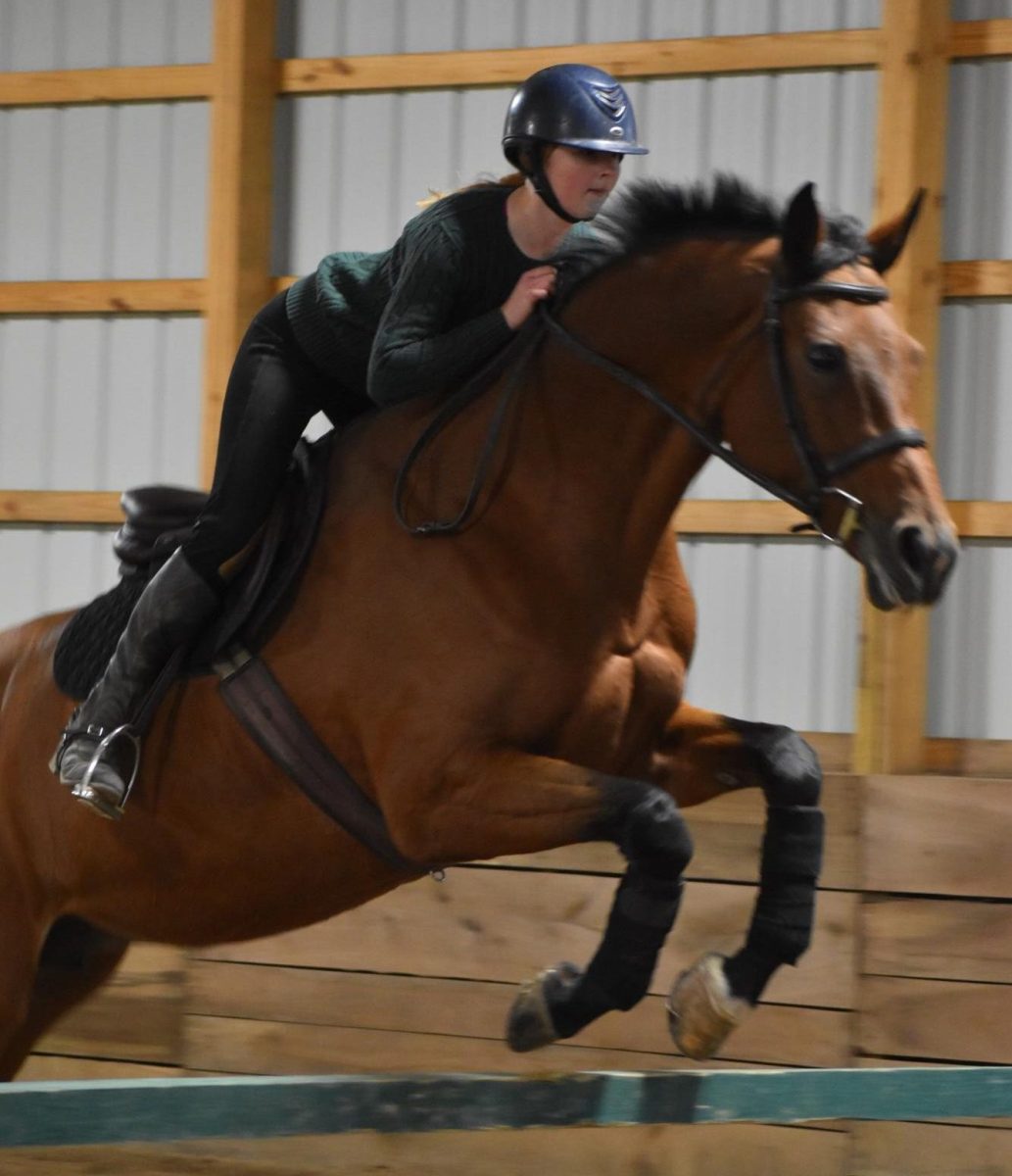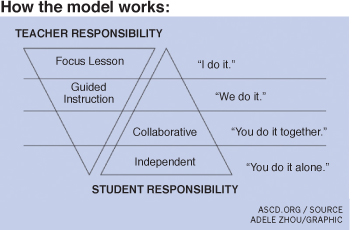Although the model for a grad ual release of responsibility in teaching has existed since 1983, developed by psychologists Pearson and Gallagher, CHS has recently begun to adopt this program. According to assistant principal Brooke Weekes, the school is piloting this program this year and is looking to move forward with it in the next few years.
ual release of responsibility in teaching has existed since 1983, developed by psychologists Pearson and Gallagher, CHS has recently begun to adopt this program. According to assistant principal Brooke Weekes, the school is piloting this program this year and is looking to move forward with it in the next few years.
The Gradual Release of Responsibility model is a teaching method that, as its name suggests, attempts to slowly shift the responsibility of education from the teachers to the students. For teachers, the idea is to progress from “I do” to “we do” and then finally “you do it together” to “you do it alone.” Ideally, the students will become self-sufficient in their learning and actively teach themselves with the teacher as a adviser rather than leader.
According to Weekes, the school has begun implementing this program by taking advantage of faculty meetings to instruct teachers in proper methods of this model. This ranges from asking teachers to involve students in greater group work to discover concepts by teaching one another rather than relying on lectures.
While we agree with the concept of the theory and think it will function in the best interest of students, there are two main issues with the application of this model that teachers must address to ensure its success.
The first deals with the actual interactions between students in a realistic group settings. The ideal situation would be a collaborative effort in which students who understand the concepts could teach them to their peers. In actuality, however, we often see how students who do understand the concept, rather than aiding their fellow students, simply do the entire workload themselves. This is counter-productive because it appears that all students grasp the concepts, so the teacher, without further scrutiny, moves on. The other problem is one that can be easily expected: the lack of student motivation. The model relies on students to take the initiative to acknowledge where they are weak and seek out help in these areas. Unfortunately, many students simply would not do so. Many of us fail to take advantage of learning resources when they are not pushed upon us.
The key to addressing these problems in a successful classroom involves greater teacher moderation of the classroom. It is inevitable that some students will attempt to work around the system to avoid putting forth effort. Therefore, it is critical that teachers seek out these types of behavior to ensure the comprehension of the subject at hand. Especially during group work, teachers should monitor the class, coming to the aid of struggling students. Furthermore, they should always be on the lookout for groups dependent on a single workhorse and break them up when necessary.
As for lack of student motivation, there are two solutions which must occur in order to dispel the problem. The first will be achieved naturally, because the problem will be magnified in early years of the program by the effects of change on students. As of now, many students haven’t yet adjusted to developing their learning skills alone. The transition may be rough, but after a full scale implementation of the policy a shift in culture across the board will counter this previous lack of experience.
This too requires the help of teachers. For students who accept their low grades and fail to make the effort to improve, teachers must intervene and return to the “we do it together” step of the model. This allows students to get the necessary help they need, without a retreat back to the lecture model.
Although these dilemmas currently exist, we still see the program as the most effective way to teach. This will better prepare students, not only for their future education, but also every future endeavor they undertake. As long as the school proceeds with caution, the program is sure to be a success.


































![British royalty are American celebrities [opinion]](https://hilite.org/wp-content/uploads/2024/03/Screenshot-2024-03-24-1.44.57-PM.png)


















![Chelsea Meng on her instagram-run bracelet shop [Biz Buzz]](https://hilite.org/wp-content/uploads/2024/04/IMG_2446-1200x838.jpg)
![Review: Quiet on Set: The Dark Side of Kids TV is the long awaited exposé of pedophilia within the children’s entertainment industry [MUSE]](https://hilite.org/wp-content/uploads/2024/04/unnamed.jpg)
![Review: “The Iron Claw” cannot get enough praise [MUSE]](https://hilite.org/wp-content/uploads/2024/04/unnamed.png)
![Review: “The Bear” sets an unbelievably high bar for future comedy shows [MUSE]](https://hilite.org/wp-content/uploads/2024/03/unnamed.png)
![Review: “Mysterious Lotus Casebook” is an amazing historical Chinese drama [MUSE]](https://hilite.org/wp-content/uploads/2024/03/0.webp)
![Review in Print: Maripaz Villar brings a delightfully unique style to the world of WEBTOON [MUSE]](https://hilite.org/wp-content/uploads/2023/12/maripazcover-1200x960.jpg)
![Review: “The Sword of Kaigen” is a masterpiece [MUSE]](https://hilite.org/wp-content/uploads/2023/11/Screenshot-2023-11-26-201051.png)
![Review: Gateron Oil Kings, great linear switches, okay price [MUSE]](https://hilite.org/wp-content/uploads/2023/11/Screenshot-2023-11-26-200553.png)
![Review: “A Haunting in Venice” is a significant improvement from other Agatha Christie adaptations [MUSE]](https://hilite.org/wp-content/uploads/2023/11/e7ee2938a6d422669771bce6d8088521.jpg)
![Review: A Thanksgiving story from elementary school, still just as interesting [MUSE]](https://hilite.org/wp-content/uploads/2023/11/Screenshot-2023-11-26-195514-987x1200.png)
![Review: When I Fly Towards You, cute, uplifting youth drama [MUSE]](https://hilite.org/wp-content/uploads/2023/09/When-I-Fly-Towards-You-Chinese-drama.png)
![Postcards from Muse: Hawaii Travel Diary [MUSE]](https://hilite.org/wp-content/uploads/2023/09/My-project-1-1200x1200.jpg)
![Review: Ladybug & Cat Noir: The Movie, departure from original show [MUSE]](https://hilite.org/wp-content/uploads/2023/09/Ladybug__Cat_Noir_-_The_Movie_poster.jpg)
![Review in Print: Hidden Love is the cute, uplifting drama everyone needs [MUSE]](https://hilite.org/wp-content/uploads/2023/09/hiddenlovecover-e1693597208225-1030x1200.png)
![Review in Print: Heartstopper is the heartwarming queer romance we all need [MUSE]](https://hilite.org/wp-content/uploads/2023/08/museheartstoppercover-1200x654.png)






















![Review: Ladybug & Cat Noir: The Movie, departure from original show [MUSE]](https://hilite.org/wp-content/uploads/2023/09/Ladybug__Cat_Noir_-_The_Movie_poster-221x300.jpg)

![Review: Next in Fashion season two survives changes, becomes a valuable pop culture artifact [MUSE]](https://hilite.org/wp-content/uploads/2023/03/Screen-Shot-2023-03-09-at-11.05.05-AM-300x214.png)
![Review: Is The Stormlight Archive worth it? [MUSE]](https://hilite.org/wp-content/uploads/2023/10/unnamed-1-184x300.png)


